Leadtek GeForce PX7800 GTX TDH MyVIVO Extreme examination
Leadtek GeForce PX7800 GTX TDH MyVIVO ExtremeIf you cast your mind back to our 3-way GeForce 7800 GTX shootout that we carried out 3 months ago, Leadtek, at that time, was the only one of three card partners whose GeForce 7800 GTX 256MB offering was reference-like in most respects. Clocked in at 430MHz core and 1200MHz memory and deviating from the NVIDIA reference model by having a Leadtek insignia, it was the slowest of our tested trio. NVIDIA's laissez-faire thinking allowed partners to practically define their own clock speeds, and we saw both BFG and XFX Technologies raise core and memory frequencies on their models, albeit with matching increases in price over Leadtek's.
Following on from that, Leadtek was keen to stress that it had more than a single GeForce 7800 GTX card in its lineup. Sure, there was the 'basic' version that adhered to the reference specifications and was positioned to appeal primarily on price. In view of the way the GeForce 7800 GTX 256MB market was panning out, even Leadtek's basic model, the PX7800 GTX TDH MyVIVO, is now guaranteed to run at 450MHz core and 1250MHz memory. If that core speed doesn't light your fire and you need something with even more oomph, and perhaps to gain some kind of performance parity with other partners' super-duper GeForce 7800 GTX cards, Leadtek's now launched an Extreme edition that keeps memory speed at 1250MHz but increases core frequency to 490MHz.

The extra 40MHz core speed, or around 9% above the basic PX7800's, has been achieved in the most visual way possible, by strapping a huge heatpipe-based cooler and extra-large fan combination on top.
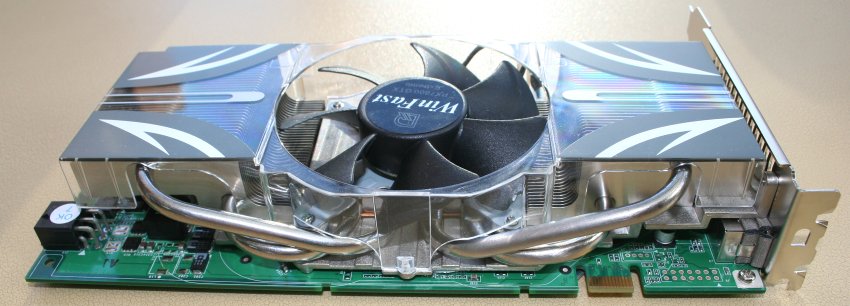
The nature of the cooling employed on the card dictates that it can only be used in systems that can accommodate models with twin backplane slots. That immediately precludes a number of PCIe-based small form-factor chassis that have space for one-slot designs. The majority of other GeForce 7800 GTX 256MB cards, be they reference or overclocked varieties, tend to ship with single-slot coolers, so you can think of this design in two ways. Firstly, the enthusiast that is likely to opt for a super-overclocked GeForce 7800 GTX such as this Leadtek version, will likely be using a full-sized case with adequate airflow. Secondly, should the user want to install a Leadtek-branded card in restrictive systems, the standard '450/1250' model features regular, single-slot cooling. The heatsink's size, then, shouldn't be a defining factor in the overall purchasing decision for most users.
In terms of cooling design, the card-long heatsink uses four heatpipes that attach to a central portion which, in turn, attaches to both the G70 core and RAM chips underneath. Once heat is transferred from the GPU and RAM modules through to the heatsink, the heatpipes then transfer this heat to a collection of cooling fins on the outer sections each side. The 40 fins on each side help increase the cooling surface area and the central, large 92mm fan, right in the middle, pushes the heat out into the case and, to some extent, behind. Thinking about it logically for a second, you kind of need a heatpipe approach for a heatsink so large, too

Here you can see the overbearing nature of the heatsink. Apart from the obvious departure in cooling, the Leadtek PX7800 GTX TDH MyVIVO Extreme is a regular G70 card underneath. The PCB measures in at 22.4cm, making it about a centimetre longer than most GeForce 7800 GTs and the same length as ATI's RADEON X1800-series of cards. There's a single PCIe 6-pin power plug that's necessary even with the extra juice available via a x16 PCI-Express slot.
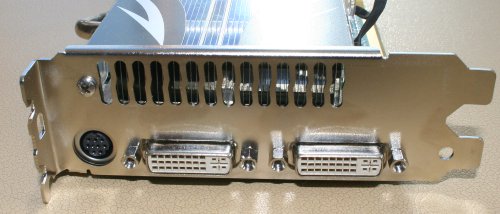
The rear shows the double-height nature of the card. Twin DVI is becoming increasingly standard on top-end cards and we're happy for that to be the case. Leadtek's card carries both single- and dual-link DVI TMDS, meaning that only the dual-link TMDS can drive displays with insane resolutions. Apple's 30-inch 2560x1600 panel always springs to mind here. For most others that top out at a more-sensible 1920x1200, a single-link DVI interface is fine. The card's name includes reference to VIVO functionality, and that's exactly what you get through the S-Video socket on the left-hand side.
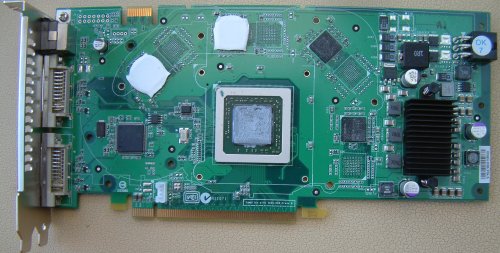
Removing the 400g oversized cooler leaves us with a fairly generic-looking GeForce 7800 GTX PCB. The power-delivery components, on the right-hand side, are cooled by another heatsink, this time passive in nature. Leadtek uses a total of 8 256MBit RAM chips with 4 on each side. They're rated to 1.6ns which equates to a clock-speed of 1250MHz; right on the money as far as this card is concerned. We've little doubt that you'll be seeing 512MB-equipped '7800 GTXs in the near future, probably with GDDR3 RAM running at even higher speeds. To the left of the large G70 GPU is where the card's MyVIVO naming derives from. Again, much like other G70-based cards, this Extreme model uses a Philips SAA7115H VIVO ASIC. Partners will only diverge on the software that's provided to take advantage of this chip's video-processing abilities.
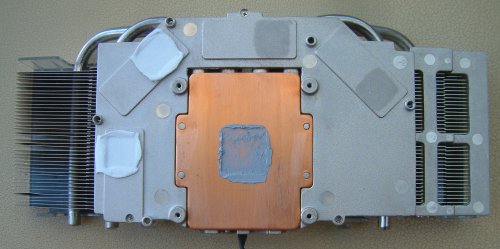
Here's the heavyweight cooler when seen from the bottom up. The central section, in contact with the GPU die, has a copper base which conducts heat faster than, say, aluminium, for better heat transfers to the heatpipes. Hopefully you can see just how the heatpipes make contact with this copper base. There's also 4 raised portions that make direct contact with the memory chips on the upper side. There's a couple of thermal pads on the left-hand side and imprints from the opposing duo on the right-hand side.
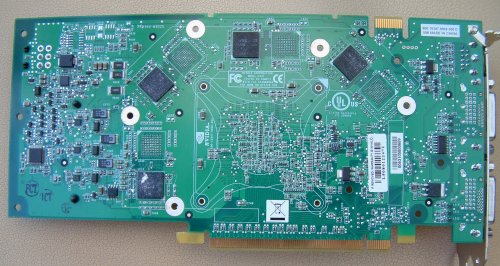
Finally, here's the rear of the card with the RAMsink removed. An SLI connector breaks up the green monotony









